COVID-19 pandemic in Europe
| COVID-19 pandemic in Europe | |
|---|---|
| Disease | COVID-19 |
| Virus strain | SARS-CoV-2 |
| Location | Europe |
| First outbreak | Wuhan, Hubei, China[1] |
| Index case | Bordeaux, France |
| Arrival date | 21 January 2020 (4 years, 2 months, 4 weeks and 1 day ago) |
| Confirmed cases | 243.000.000+[2] |
| Recovered | 239.000.000+[2] |
Deaths | ~2.000.000[2] |
Territories | 57 |
| Part of a series on the |
| COVID-19 pandemic |
|---|
 |
|
| |
The global COVID-19 pandemic arrived in Europe with its first confirmed case in Bordeaux, France, on 24 January 2020, and subsequently spread widely across the continent. By 17 March 2020, every country in Europe had confirmed a case,[3] and all have reported at least one death, with the exception of Vatican City.
Italy was the first European country to experience a major outbreak in early 2020, becoming the first country worldwide to introduce a national lockdown.[4] By 13 March 2020, the World Health Organization (WHO) declared Europe the epicentre of the pandemic[5][6] and it remained so until the WHO announced it was overtaken by South America on 22 May.[7] By 18 March 2020, lockdowns introduced in Europe affected more than 250 million people.[8] Despite deployment of COVID-19 vaccines, Europe became the pandemic's epicentre once again in late 2021.[9] On 11 January 2022, Dr. Hans Kluge, the WHO Regional Director for Europe said, "more than 50 percent of the population in the region will be infected with Omicron in the next six to eight weeks".[10]
As the outbreak became a major crisis across Europe, national and European Union responses have led to debate over restrictions of civil liberties and the extent of European Union solidarity.
As of 20 May 2022, Europe is the most affected continent in the world. Most affected countries in Europe include France, Germany, the United Kingdom and Russia.
International comparisons[edit]
In March 2022, The Lancet published a study comparing excess mortality rates per 100,000 population, in 191 countries in the world, over the first two years of the pandemic (2020 and 2021). The study showed that amongst the major western European countries, those with the highest rates were Italy with 227, Portugal 202, Spain 187, Belgium 147, and the Netherlands 140. The average was 140 and below that were the United Kingdom at 127, France 124, and Germany 121 - the difference between these three was not statistically significant - and that Ireland (13) and the Scandinavian countries had lower rates.[11][12][medical citation needed]
Economic activity decreased by almost 4% in the majority of sub-regions in Europe in 2020, which was similar to the global average of 3.2%. However, the variance between nations is prominent. The high infection and mortality rates of the pandemic in countries in the Western Balkans, the Eastern Neighbourhood, and Central and Eastern Europe meant they faced deeper recessions.[13][14]
From 2019 to 2020, there was also a difference in how EU countries were adapting to new COVID-19 regulations, one of them being work from home. The proportion of EU enterprises employing advanced digital technology in their operations expanded dramatically during that time. From 2020 to 2021, this percentage remained relatively stable, reaching 61% in 2021, compared to 63% in 2020 and 58% in 2019.[15][16]
Since the beginning of 2020, EU enterprises that embraced advanced digital technology and invested in becoming more digital during the pandemic have increased the number of employees they employ.[15][17][18] The number of non-digital enterprises that downsized was also greater than the share of non-digital firms that had positive job growth. Non-digital companies had a negative net employment balance.[15][19]
The Czech Republic was the top-performing EU country[according to whom?] for the usage of advanced digital technologies during the pandemic.[15][20] Finland was the top performing EU country in terms of digital infrastructure and the use of formal strategic business monitoring. [15][21][20] Austria is leading[how?] digitalization adoption during the COVID-19 pandemic.[15][20] Cyprus is leading software and data investment.[15][20] Sweden is at the top[how?] for investing in digital training for their employees.[15][20]
Statistics by country and territory[edit]
| Country/Territory | Tests[24] | Reported cases | Reported deaths | Reported deaths per 1M population[24] | Estimated excess mortality per 1M population 2020 and 2021[25] | Recoveries | Ref |
|---|---|---|---|---|---|---|---|
| 1,529,669 | 334,090 | 3,604 | 1,218 | 3,465 | 330,233 | [26][27] | |
| 249,838 | 48,015 | 159 | 1,974 | 2,055 | 47,806 | [28] | |
| 126,775,946 | 6,081,287 | 22,534 | 2,053 | 1,075 | no data | [29][30][31] | |
| 11,193,320 | 994,037 | 7,118 | 739 | 4,831 | 928,536 | [32][33] | |
| 27,823,927 | 4,833,699 | 34,339 | 2,722 | 1,466 | no data | [34][35][36] | |
| 1,505,807 | 403,364 | 16,369 | 4,873 | 3,339 | no data | [37][38][39] | |
| 7,692,793 | 1,331,456 | 38,657 | 5,434 | 6,473 | 1,289,148 | [40] | |
| 3,877,819 | 1,274,603 | 18,306 | 3,949 | 2,856 | 1,255,955 | [41] | |
| 9,477,138 | 660,854 | 1,364 | 871 | 322 | no data | [42][43] | |
| 47,516,725 | 4,700,505 | 43,090 | 3,750 | 2,448 | no data | [44][45] | |
| 110,395,437 | 3,418,520 | 8,838 | 1,100 | 941 | no data | [46][47][48] | |
| 2,590,874 | 618,218 | 3,001 | 1,938 | 2,267 | 614,656 | [49][50] | |
| 657,000 | 34,658 | 28 | 569 | — | no data | [51][52] | |
| 8,803,391 | 1,508,603 | 10,184 | 848 | 808 | no data | [53][54][55] | |
| 188,795,159 | 39,997,490 | 167,985 | 2,270 | 1,242 | no data | [56][57][58] | |
| 89,622,218 | 38,437,756 | 174,979 | 1,663 | 1,205 | no data | [59][60][61] | |
| 460,732 | 20,550 | 113 | 3,029 | — | no data | [62][63] | |
| 50,386,399 | 5,482,697 | 37,959 | 2,908 | 1,271 | no data | [64][65][66] | |
| — | 35,326 | 41 | — | — | 35,151 | [67] | |
| 9,285,125 | 2,217,132 | 48,862 | 4,845 | 2,978 | 2,118,911 | [68][69] | |
| 1,425,512 | 209,191 | 260 | 443 | -478 | no data | [70] | |
| 11,785,169 | 1,725,026 | 9,366 | 1,566 | 125 | no data | [71] | |
| 133,676 | 38,008 | 116 | 1,246 | — | no data | [72][73] | |
| 148,159,131 | 26,530,885 | 194,064 | 2,777 | 2,274 | 26,112,216 | [74] | |
| — | 66,391 | 161 | — | — | 66,170 | [75] | |
| — | 274,269 | 3,212 | — | — | no data | [76][77] | |
| 5,684,399 | 977,068 | 7,430 | 3,164 | 3,520 | no data | [78][79][80] | |
| 80,432 | 21,526 | 87 | 2,217 | — | 16,199 | [81][82] | |
| 6,727,723 | 1,355,324 | 9,769 | 3,457 | 3,850 | no data | [83][84][85] | |
| 3,847,888 | 386,030 | 1,000 | 1,679 | 892 | no data | [86][87] | |
| 1,216,068 | 120,739 | 885 | 1,638 | 899 | no data | [88][89] | |
| 2,478,148 | 627,458 | 12,154 | 2,877 | 2,452 | no data | [90][91] | |
| 54,960 | 17,181 | 67 | 1,433 | 744 | no data | [92][93] | |
| 1,034,265 | 251,180 | 2,654 | 4,333 | 3,570 | no data | [94][95] | |
| 21,107,399 | 8,610,372 | 22,992 | 1,298 | 1,400 | no data | [96][97] | |
| 1,659,878 | 349,923 | 9,960 | 4,472 | 5,836 | no data | [98][99][100] | |
| 9,447,282 | 1,493,079 | 5,732 | 583 | 72 | no data | [101][102][103] | |
| 27,922,598 | 6,605,712 | 119,992 | 3,081 | 2,972 | 5,335,750 | [104][105] | |
| 27,780,292 | 5,633,203 | 27,738 | 2,321 | 2,022 | no data | [106][107] | |
| 17,519,846 | 3,503,553 | 68,601 | 3,461 | 3,287 | no data | [108][109] | |
| 242,900,000 | 22,995,765 | 399,999 | 2,602 | 3,746 | 22,446,519 | [110] | |
| 109,538 | 25,292 | 126 | 3,375 | 1,896 | 23,160 | [111][112] | |
| 7,418,399 | 2,601,133 | 18,057 | 1,857 | 2,289 | no data | [113] | |
| 5,184,086 | 1,869,657 | 21,167 | 3,681 | 2,504 | no data | [114] | |
| 2,143,592 | 1,349,318 | 7,100 | 3,195 | 1,799 | no data | [115][116] | |
| 66,213,858 | 13,980,340 | 121,852 | 2,289 | 1,867 | no data | [117][118] | |
| 15,268,363 | 2,734,805 | 24,513 | 1,860 | 912 | no data | [119][120] | |
| 14,772,127 | 4,422,292 | 13,680 | 1,591 | 931 | no data | [121][122][123] | |
| 122,223,026 | 17,004,677 | 101,419 | 1,149 | 1,186 | no data | [124][125] | |
| 16,956,514 | 5,520,483 | 109,918 | 2,513 | 2,217 | no data | [126][127] | |
| 418,708,539 | 24,812,582[a] | 232,112[b] | 2,614[b] | 1,268 | no data | [128][129] | |
| — | 29 | 0 | — | — | 29 | [130][131] | |
| Total/average | 1,898,102,976 | 163,877,845 | 1,776,085 | 2,141 |
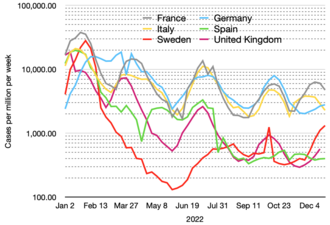
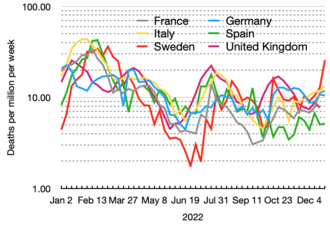

In late August, 88% of COVID-19 deaths in Europe were among people over age 65, according to a 30 August report from the WHO.[132]

Pandemic by country and territory[edit]
Albania[edit]
The COVID-19 pandemic in Albania was a part of the worldwide pandemic of coronavirus disease 2019 (COVID-19) caused by severe acute respiratory syndrome coronavirus 2 (SARS-CoV-2). The first case in the Republic of Albania was reported in Tirana on 8 March 2020, when a patient and his adult son who had come from Florence, Italy tested positive.[134] Both men later recovered.
On 21 December 2020, health minister Ogerta Manastirliu announced that the country has decided to suspend flights to and from the UK until 6 January 2021 because of what was then a new COVID-19 mutation that transmits more quickly than other variants. All passengers arriving from the UK by land had to self-isolate for 14 days upon entry. The flight suspension took effect on Tuesday, 22 December.[135]
As of 4 February 2023, 3,058,102 COVID-19 vaccine doses have been administered in Albania.[136]Andorra[edit]
Austria[edit]
The COVID-19 pandemic in Austria was a part of the worldwide pandemic of coronavirus disease 2019 (COVID-19) caused by severe acute respiratory syndrome coronavirus 2 (SARS-CoV-2). In Austria, a pair of cases were confirmed on 25 February 2020. The cases involved a 24-year-old man and a 24-year-old woman who were travelling from Lombardy, Italy, and were treated at a hospital in Innsbruck.[139][140][141][142] According to new figures released by Austrian authorities on 23 June, the first case in the country was recorded in Ischgl, Tyrol on 8 February.[143]
As of 4 February 2023, a total of 20,369,447 vaccine doses have been administered.[144]Belarus[edit]
Belgium[edit]
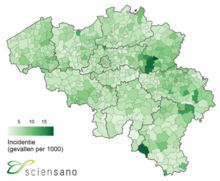
This article needs to be updated. (February 2022) |
The COVID-19 pandemic in Belgium has resulted in 4,861,011[148] confirmed cases of COVID-19 and 34,339[148] deaths.
The virus was confirmed to have spread to Belgium on 4 February 2020, when one of a group of nine Belgians repatriated from Wuhan to Brussels was reported to have tested positive for the coronavirus.[149][150] Transmission within Belgium was confirmed in early March; authorities linked this to holidaymakers returning from Northern Italy at the end of the half-term holidays.[151][152] The epidemic increased rapidly in March–April 2020. By the end of March all 10 provinces of the country had registered cases.[citation needed]
By March 2021, Belgium had the third highest number of COVID-19 deaths per head of population in the world, according to data compiled by Johns Hopkins University. However, Belgium may have been over-reporting the number of cases, with health officials reporting that suspected cases were being reported along with confirmed cases.[153] Unlike some countries that publish figures based primarily on confirmed hospital deaths, the death figures reported by the Belgian authorities included deaths in the community, such as in care homes, confirmed to have been caused by the virus, as well as a much larger number of such deaths suspected to have been caused by the virus, even if the person was not tested.[154]Bosnia and Herzegovina[edit]
The COVID-19 pandemic in Bosnia and Herzegovina was a part of the worldwide pandemic of coronavirus disease 2019 (COVID-19) caused by severe acute respiratory syndrome coronavirus 2 (SARS-CoV-2). The virus was confirmed to have reached Bosnia and Herzegovina on 5 March 2020, when a patient in Banja Luka, who had travelled to Italy, tested positive. Later on the same day, a second case, who was the son of the first case, was reported.[155] On 21 March, the first death in the country from COVID-19 was announced in a hospital in Bihać. The patient was an elderly woman who had been hospitalized two days before.[156]
On 17 March, the Council of Ministers of Bosnia and Herzegovina declared a state of emergency in the entire country.[157]
Bosnia and Herzegovina has one of the highest rates of COVID-19 deaths in the world as well as one of the lowest test rates in Europe.[158]
As of 28 January 2022, 1,924,950 COVID-19 vaccine doses have been administered in Bosnia and Herzegovina.[159]Bulgaria[edit]
The COVID-19 pandemic in Bulgaria was a part of the worldwide pandemic of coronavirus disease 2019 (COVID-19) caused by severe acute respiratory syndrome coronavirus 2 (SARS-CoV-2). The virus was confirmed to have spread to Bulgaria when the country's first cases, a 27-year-old man from Pleven and a 75-year-old woman from Gabrovo, were confirmed on 8 March 2020. Neither of the two had traveled to areas with known coronavirus cases which is maybe because the PCR test that was used is defective. The man tested positive for the virus after being hospitalized for a respiratory infection, and authorities announced plans to test several people who were in contact with the two individuals.[160] Two other samples in Pleven and Gabrovo were positive on 8 March.[161] Patient zero remains unknown.[162]
After the number of patients in the country had reached 23, the Bulgarian Parliament voted unanimously to declare a state of emergency from 13 March until 13 April.[163] A 14-day preventive house quarantine was introduced for citizens who have been in contact with a COVID-19 patient or have returned from an overseas region with a high number of cases. For patients tested positive for the virus a 21-day house quarantine was introduced. This time span is counted from the day a subsequent test comes out negative after they have been treated in a hospital or at home. After the World Health Organization (WHO) has established that COVID-19 is more resilient than the initial data was showing, the National Crisis-management Staff increased the recovery house quarantine by a week to 28 days.[164] With the continuing increase of COVID-19 cases on a daily basis, the Bulgarian government requested on 1 April that Parliament extend the state of emergency by one month until 13 May.[165]
As of 5 February 2023, a total of 4,612,386 vaccine doses have been administered.[166]Croatia[edit]
On 25 February, Croatia confirmed its first case, a 26-year-old man who had been in Milan, Italy.[167] On 26 February, two new cases were confirmed, one being the twin brother of the first.[168] In March 2020, a cluster of cases were reported in numerous Croatian cities. On 12 March, the first recovery was reported, and on 18 March the first death from the virus was confirmed. On 19 March, the number of recorded cases surpassed 100. On 21 March, it surpassed 200. On 25 March, it surpassed 400. On 31 March, it surpassed 800. The pandemic in Croatia occurred during the Croatian Presidency of the Council of the European Union.[169]
On 22 March, an intense earthquake hit Zagreb, the capital of Croatia, causing problems in enforcement of social distancing measures set out by the Government. The earthquake could also be felt across much of Croatia, Bosnia and Herzegovina, Hungary, Slovenia, and Austria.[170][171]
According to Oxford University, as of 24 March, Croatia was the country with the world's strictest restrictions and measures for infection reduction in relation to the number of infected.[172] The government set up a website for all information about the virus and a new phone line 113 that has volunteers answering questions.[173]
Cyprus[edit]
On 9 March, Cyprus confirmed its first two cases, one in Nicosia and one in Limassol.[174][non-primary source needed][175][176]
Cases reached 500 in April, 1,000 in July, 4,000 in October and 10,000 in November.[citation needed]
Czech Republic[edit]

The first case was reported in the country on 1 March.[44] As of 22 March there had been 1120 confirmed cases, with one lethal outcome.[44]
On 12 March, the Czech Republic declared a 30-day state of emergency and barred entry to non-residents from China, South Korea, Iran, Italy, Spain, Austria, Germany, Switzerland, Sweden, UK, Norway, Denmark and France.[177]
The Czech Republic banned people from going out in public without wearing a face mask or covering their nose and mouth.[178]
Denmark[edit]
On 27 February, 2020, Denmark confirmed its first case.[179]
As of 16 March, 2020, there have been 898 confirmed cases in Denmark, including 11 in the Faroe Islands (see below).[180]
Numerous preventive measures gradually were implemented. Starting on 13 March, 2020, schools, universities and similar places were closed, while most people in non-essential functions have been sent home to work.[181] On 14 March, 2020, the borders were closed for all entries, except Danish citizens, people with a residence permit, people with an important reason for visiting, and transport of goods.[182][177]
Estonia[edit]
On 27 February, Estonia confirmed its first case, an Iranian citizen, travelling from Iran via Turkey.[183]
As of 11 March, there were 17 confirmed cases in Estonia. 12 of them had returned with the infection from Northern Italy, one from France, one from Iran and one from undisclosed risk area.[184][185] First two cases of virus transmitting locally were in Saaremaa after international volleyball competition involving a team from Milan.[186]
From 12 March, the virus was spreading locally. The number of infected grew fast reaching 109 on 14 March.[187]
Finland[edit]
The first case was reported in the country on 28 January.[188][189] As of 21 July there were over 7,000 confirmed cases.[190] As of 9 December (2020) the confirmed cases in Finland are 28,732 over the entire period.[191] A total of 433 deaths associated with the disease have been reported until now.[192]
France[edit]

On 24 January, the first case in Europe was confirmed in Bordeaux. Two more cases were confirmed in Paris by the end of the day, all of them originated from China. A cluster of infections was discovered in Haute-Savoie which originated from a British national who had visited Singapore.[193][194][195]
From 31 January to 9 February, nearly 550 people were repatriated from Wuhan on a series of evacuation flights arriving at Creil Air Base in Oise and Istres-Le Tubé Air Base in Istres.[196]
On 14 February, an 80-year-old Chinese tourist died in Bichat–Claude Bernard Hospital, Paris, marking the first death from COVID-19 in Europe and France.[197]
According to regional council president Jean Rottner, the starting point for the first intense wave in Alsace was the Fasting Meeting of the Protestant Free Church of La Porte Ouverte in Mulhouse, with more than 2500 visitors, in mid-February.[198] On 12 March, French president Emmanuel Macron announced on public television that all schools and all universities would close from Monday 16 March until further notice. The next day, the Prime Minister Édouard Philippe banned gatherings of more than 100 people, not including public transportation. The following day, the prime minister ordered the closure of all nonessential public places, including restaurants, cafés, cinemas, and discothèques, effective at midnight.[199]
As of 14 March, there had been 4,499 confirmed cases (a near-four-fold increase over the number 5 days previously), and 91 deaths in France.[200]
As of 20 March, the number of confirmed cases had risen to 12,612, while the number of deaths reached 450.[citation needed] As of 30 March, more than six hundred doctors and other medical workers are suing the former Minister of Health and the Prime Minister for "culpable negligence" in failing to prepare for the epidemic.[201]
Until 1 April, the daily update of the number of deaths in France included only deaths in hospitals, with deaths in retirement homes or at home not included in the update.[202] Deaths in retirement homes were included in the reported figures from 2 April, causing totals to increase substantially.[203]
On 4 May, retroactive testing of samples in one French hospital showed a patient "who had COVID-19 as early as Dec. 27, nearly a month before the French government confirmed its first cases."[204] According to the researchers who reported the discovery, this indicates that the virus was present in the population well before the first confirmed cases, a finding also echoed by US researchers.[205] In July 2020, Prime Minister of France Jean Castex, announced that health care pay workers will see $9 billion in pay raises, as a result of their efforts during the coronavirus pandemic.[206]
Germany[edit]
In Germany, the first case of COVID-19 was recorded in the state of Bavaria on 27 January 2020. Daily case numbers began to decrease after 8 April, but rose sharply again in October. As of 30 January 2021,[update] 2,207,393 cases have been reported with 56,286 deaths and approximately 1,930,592 recoveries.[207][208][209][210][211] The case fatality rate is 2.5%.[212] The low preliminary fatality rate in Germany, compared to Italy and Spain, has resulted in a discussion and explanations that cite among others the country's higher number of tests performed, absence of COVID-19 analyses in autopsies and higher proportion of positive cases among younger people. Hessian state finance minister Thomas Schäfer committed suicide on 28 March 2020. State Premier Volker Bouffier said that Schäfer had had considerable worries in particular over the economic burden that the COVID-19 pandemic would place on the population.[213]
Gibraltar[edit]
First case was identified on 4 March 2020, only 187 cases to the end of July then increases with 100 added in August and the same in September. A contact App "BEAT Covid Gibraltar" was released on 18 June.[214]
Greece[edit]
On 26 February 2020, the first case in Greece was confirmed, a 38-year-old woman from Thessaloniki who had recently visited Northern Italy.[215] The next day, the first patient's 9-year-old child and another 40-year-old woman, who had travelled to Italy, also tested positive.[216][217][218] Subsequent cases is Greece were mainly related to people who had travelled to Italy and a group of pilgrims who had travelled to Israel and Egypt, as well as their contacts.[219][220] Health and state authorities issued precautionary guidelines and recommendations, while measures up to that point were taken locally and included the closure of schools and the suspension of cultural events in the affected areas (particularly Ilia, Achaea and Zakynthos).[220] The first confirmed death from COVID-19 in Greece was a 66-year-old man, who died on 12 March.[221]
By 27 July there were 4,227 confirmed cases in Greece, some of which detected among tourists arriving to the country from mid-June onwards, 202 deaths and 3,562 recoveries.[222][223] The Greek National Public Health Organization (NPHO), in collaboration with local authorities and doctors, is tracking and testing everyone who came in close contact with the patients.[224][225] By 10 March, with 89 confirmed cases and no deaths in the country, the government decided to suspend the operation of educational institutions of all levels nationwide and then, on 13 March, to close down all cafes, bars, museums, shopping centres, sports facilities and restaurants in the country.[226][227] On 16 March, all retail shops were also closed and all services in all areas of religious worship of any religion or dogma were suspended.[228][229] On 18 and 19 March, the government announced a series of measures of more than 10 billion euros to support the economy, businesses and employees.[230]
On 22 March the Greek authorities announced significant restrictions on all nonessential transport and movement across the country, starting from 6 a.m. on 23 March.[231] Starting from 4 May, Greece has begun easing its lockdown restrictions after a 42-day lockdown, with the gradual lifting of movement restrictions and restart of business activity.[232]
Guernsey[edit]
On 9 March, the first case in the Crown dependency was confirmed.[233] On 27 May it was announced that there were no known active cases in the Bailiwick.[234] There were no active cases for 129 days before an arrival from the UK tested positive on 6 September.[235]
Hungary[edit]
On 4 March Prime Minister Viktor Orbán announced that two Iranian students had been infected with the virus.[236] The students are asymptomatic and have been transported to Saint Ladislaus Hospital in Budapest.[236]
Iceland[edit]
The first case was confirmed in Iceland on 28 February, an Icelandic male in his forties who had been on a ski trip to Andalo in Northern Italy and returned home on 22 February.[237]
Iceland's Department of Civil Protection and Emergency Management declared a state of emergency on 6 March after two cases of community transmission in Iceland were confirmed, bringing the total number of confirmed cases to 43.[238] On 13 March, it was announced at an official press conference that a four-week ban on public gatherings of more than 100 persons would be put into effect as of Monday 16 March. Universities and secondary schools will be closed for four weeks. International airports and harbours will remain exempt from these measures.[239]
Ireland[edit]

The National Public Health Emergency Team of Ireland announced the first case in the Republic of Ireland on 29 February, involving a male student from the east of the country, who had arrived there from Northern Italy.[240][241][242] On 3 March, a second case was confirmed of a female in the east of the country who had been to Northern Italy.[243] Response to the outbreak has included cancellation of St Patrick's Day parades and all festivals.[244] On 11 March, an elderly patient in Naas General Hospital in County Kildare became Ireland's first fatality from the virus.[245] On 12 March, Taoiseach Leo Varadkar announced the closure of all schools, colleges and childcare facilities.[246] On 20 March, an emergency legislation was signed into law by President Michael D. Higgins giving the state permission to detain people, restrict travel and keep people in their homes to help combat the spread of the pandemic.[247]
Lockdown[edit]
On 12 March 2020, Taoiseach Leo Varadkar announced the closure of all schools, colleges and childcare facilities in Ireland until the end of August.[248] On 27 March, Varadkar announced a national stay-at-home order for at least two weeks; the public were ordered to stay at home in all circumstances. All non-essential shops and services, including all pubs, bars, hotels and nightclubs closed and all public and private gatherings of any number of people was banned.[249] The Garda Síochána (Irish police) were given power to enforce the measures, which were repeatedly extended until 18 May.[250]
A roadmap to easing restrictions in Ireland that included five stages was adopted by the government on 1 May 2020 and subsequently published online.[251] The fourth and final phase of easing COVID-19 restrictions in Ireland was initially scheduled to take place on 20 July, but was repeatedly postponed until 31 August at the earliest.[252]
On 15 September, the Government announced a medium-term plan for living with COVID-19 that included five levels of restrictions.[253]
All non-essential businesses and services closed and all public and private gatherings of any number of people was banned again on 21 October following the Government's announcement to move the entire country to Level 5 lockdown restrictions for six weeks until 1 December.[254] On 27 November, the Government agreed to ease restrictions from 1 December.[255]
A third wave of COVID-19 arrived in Ireland on 21 December.[256] The Government acted swiftly and on 22 December, Level 5 lockdown restrictions with a number of adjustments were announced, which came into effect from Christmas Eve until 12 January 2021 at the earliest.[257]
All non-essential businesses and services closed and all public and private gatherings of any number of people was banned again on 31 December (New Year's Eve) following the Government's announcement to move the entire country to full Level 5 lockdown restrictions from 30 December until 31 January 2021 at the earliest, in an attempt to get a third surge in cases of COVID-19 under control.[258] On 26 January, the Government extended the Level 5 lockdown restrictions until 5 March.[259] On 23 February, the Government extended the Level 5 lockdown restrictions for another six weeks until 5 April (Easter Monday) at the earliest, while its new revised Living with COVID-19 plan was published.[260]
On 30 March, the Government announced a phased easing of restrictions from Monday 12 April.[261] On 29 April, the Government announced a reopening plan for the country throughout May and June from 10 May,[262] with a further reopening planned announced on 31 August that would see all remaining COVID-19 restrictions in Ireland eased by 22 October.[263]
After a fourth wave of COVID-19 arrived in Ireland in October, the Government published on 19 October a revised plan for the easing of restrictions, with nightclubs allowed to reopen, however the continued use of masks, vaccine certificates and social distancing measures would remain in place until at least February 2022.[264] On 3 December, the Government reintroduced a series of measures that would commence from 7 December amid concerns of the Omicron variant, with nightclubs to close, indoor cultural and sporting events to operate at 50% capacity and a maximum of four households allowed to meet indoors.[265]
The Omicron variant caused a fifth wave of COVID-19 to arrive in late December and early January 2022, with record levels of cases reported over the Christmas and New Year period.[266] As cases began to fall sharply, Taoiseach Micheál Martin announced on 21 January the easing of almost all COVID-19 restrictions, with the requirements of vaccine certificates and social distancing to end, restrictions on household visits and capacity limits for indoor and outdoor events to end, nightclubs to reopen and pubs and restaurants to resume normal trading times, while rules on isolation and the wearing of masks would remain.[267] Remaining COVID-19 restrictions were agreed to be removed from 28 February, with mask wearing in schools, indoor retail settings and on public transport to be voluntary, restrictions in schools to end and testing to be scaled back.[268]
As of 21 February 2022, the Department of Health have confirmed 1,276,778 confirmed cases and 6,443 deaths.[269]
Italy[edit]
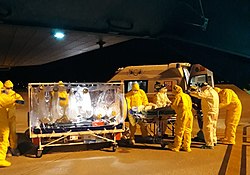
On 31 January, the first two cases were confirmed in Rome. Two Chinese tourists, who arrived in Milan on 23 January via Milan Malpensa Airport and travelled to Rome on a tourist bus, tested positive for and were hospitalised in Lazzaro Spallanzani National Institute for Infectious Diseases.[270]
On 6 February, one of the Italians repatriated from Wuhan, China, tested positive, bringing the total number of cases in Italy to three.[271] On 22 February, the repatriated Italian recovered and was discharged from the hospital.[272] On 22 and 26 February, the two Chinese tourists hospitalized in Rome tested negative.[273]
On 21 February, a cluster of cases was detected starting with 16 confirmed cases in Lombardy,[274] with additional 60 cases on 22 February,[275] and Italy's first deaths reported on the same day.[276] As of late February, Italy was hit harder than anywhere else in the EU by the COVID-19 pandemic.[277]
By 17 March 2020, there were 2,503 deaths and 31,506 confirmed cases.[278] By 15 May 2020, there had been 223,885 cases and 31,610 deaths, according to Protezione Civile bulletins.[citation needed]
On 3 June, Italy reopened its borders to EU residents and ended travel restrictions.[citation needed]
On 13 July, the Head of the ICU at a Bergamo hospital said that former patients treated for COVID-19 had developed serious long-term health issues.[279]
Cases reached 100,000 in March, 200,000 in April, 300,000 in September, 600,000 in October and 1,600,000 in November.[citation needed]
Lockdown[edit]
On 8 March, Italian prime minister Giuseppe Conte signed a decree enacting a quarantine for the entire region of Lombardy – home to more than 10 million people and the financial capital, Milan – and multiple other provinces, totalling around 16 million residents. The lockdown decree included the power to impose fines on anyone caught entering or leaving Lombardy, the worst-affected region, until 3 April.[280]
On 9 March, the lockdown orders were extended to the whole of Italy, effectively quarantining more than 60 million people.[281]
On 20 November 2020, according to high-frequency data, the lockdowns in France and Italy weighed down on public mobility more than in any other European country. France's official statistic agency INSEE found that the data collected by Google on the amount of time people spend at home is particularly closely correlated with the percentage of slow down experienced by an economy during the lockdown.[282]
Jersey[edit]
The first case was recognised on 10 March which resulted within days in flights and ferries being cancelled except for essential travel and freight, thus isolating the island by the end of March.[283][284] By 30 June there were no active cases although there have since been small numbers of cases brought into the island when lockdown was relaxed and travel permitted. On 14 October a contact App was launched.[285] Community contracted cases caused numbers to rise from 600 to 1,000 in November resulting in another lockdown.[citation needed]
Kosovo[edit]
The first two cases in Kosovo were reported on 13 March. In the ten-day period 13–23 March, the number of positive cases with coronavirus rose to 35. In midnight of 23 March 26 new cases were confirmed, bringing the total number of cases to 61.[286] Kosovars were required to wear masks and not visit their families across the street due to the lockdowns, the income and sales tax was also reduced by local governments.[287]
Latvia[edit]
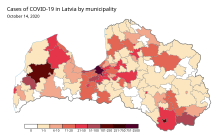
The COVID-19 pandemic in Latvia was a part of the worldwide pandemic of coronavirus disease 2019 (COVID-19) caused by severe acute respiratory syndrome coronavirus 2 (SARS-CoV-2). The virus was confirmed to have reached Latvia on 2 March 2020, having been brought along with people returning from abroad.
The government declared a state of emergency on 13 March 2020 with a number of epidemiological safety measures and restrictions, primarily limiting gatherings, travel, most public venues, and educational institutions. As the new confirmed cases stayed in the low two-digit range per day, the emergency was periodically extended until mid-2020, when the confirmed infection case dropped to almost 0 and the state of emergency ended on 9 June 2020. Most restrictions were lifted.
The rates spiked again by the end of September, from a few dozen per day to low hundreds by November, and many of the restrictions were restored and tightened, including a range of new ones. Eventually, a new state of emergency was reinstated on 9 November 2020 with increased rules and restrictions, while the daily cases reached close to one thousand by the end of November. The number of cases kept rising at the turn of the year and the state of emergency was extended to 6 April 2021. The vaccination programme began at the start of the year.
As of 21 January 2023, 2,974,692 COVID-19 vaccine doses had been administered in Latvia.[288]Liechtenstein[edit]
The first case was reported in the country on 3 March.[289]
Lithuania[edit]
The first case was reported in the country on 28 February. By 17 March there were 21 cases, mostly in Vilnius, Kaunas and Klaipėda. The first infected Lithuanian recovered on 14 March.[290] Cases reached 2,000 in July, 10,000 in October and 50,000 in November.
Luxembourg[edit]
The first case was reported in the country on 29 February. Positive cases exceeded 6,600 on 30 June and 8,500 on 30 September.
Malta[edit]
On 7 March, Malta reported its first 3 cases of coronavirus: an Italian family consisting of a 12-year-old girl and her parents, who arrived in Malta on 3 March from Rome after a holiday in Trentino. Until around September, there were barely any cases; with that maximum cases per day at around 30. But then a big wave hit Malta and cases were being of over 100 everyday, and the most cases found in a single day was 510. Then in May 2021, the cases started calming down with Malta as of 20 June 2021 having just under 50 active cases, with over 30 thousand total.[291]
Moldova[edit]

(21 December 2021)
The COVID-19 pandemic in Moldova was a part of the worldwide pandemic of coronavirus disease 2019 (COVID-19) caused by severe acute respiratory syndrome coronavirus 2 (SARS-CoV-2). The virus was confirmed to have reached the Republic of Moldova on 7 March 2020, when a Moldovan woman who returned from Italy tested positive for the novel coronavirus. As the number of infected people started to rise during the next days, the Parliament declared a state of emergency on 17 March 2020 for the entire territory of the Republic of Moldova for a period of 60 days (17 March to 15 May 2020).
On 15 May 2020, the last day of the state of emergency declared by the Parliament on 17 March 2020, the Extraordinary National Commission of Public Health declared the state of emergency in public health for the entire territory of Moldova for the period of 16 May to 30 June 2020. On 9 June 2020, the total number of confirmed cases surpassed 10,000. On 1 September 2020, the number of deaths surpassed 1,000.
The vaccination process started on 2 March 2021 with AstraZeneca vaccine units donated by Romania to Moldova.Monaco[edit]
The first case was reported in the country on 29 February.[292][non-primary source needed][293]
Montenegro[edit]
The COVID-19 pandemic in Montenegro has resulted in 251,280[148] confirmed cases of COVID-19 and 2,654[148] deaths.
The first case of the disease in Montenegro was confirmed on 17 March 2020,[294][295] making it the last European country to register a case of SARS-CoV-2.[296] On 24 May 2020, 68 days after the first case was recorded in Montenegro, it became the first COVID-19-free country in Europe. Within the first outbreak, indexed cases counted 9% of the total reported, 80% of cases were infected due to contact with primary cases, while the origin of infection of the other 11% of cases was not certain.[297] The Government of Montenegro estimated that the country needs EUR 59.2 million private and international relief to address the health, social and economical impact of COVID-19.[298]
Montenegro had no active cases from 24 May until 14 June 2020, when the first imported case was reported.
As of 3 December 2022, 523,735 COVID-19 vaccine doses have been administered in Montenegro.[299]Netherlands[edit]
On 27 February, the Netherlands confirmed its first case, a man who had been in the Lombardy region of Italy.[300]
On 6 March, RIVM announced the first death.[301]
On 9 March, RIVM announced 56 more confirmed cases in addition to the total of the 77 infected patients declared in the previous day, bringing the total to 321 infected and 3 dead.[302]
On 15 March, the Dutch government announced in a press conference that all schools, day care facilities, colleges, universities, and universities of applied sciences would close until 6 April, though children of parents in vital industries could still go to school or the day care if they could not be taken care of otherwise.[303]
As of 16 March, the total number of confirmed cases of COVID-19 had risen to 1,413 and the total number of confirmed deaths had risen to 24. This was an increase of 278 infections and 4 deaths in comparison to 15 March.[304]
On the same date, the Prime Minister of the Netherlands, Mark Rutte, had announced that the country would not go into complete lockdown. Instead the situation would be controlled as much as possible by delaying the spread of the virus, relying on measures taken earlier by the government, such as social distancing and prohibiting gatherings of 100 people and over.[305] It is expected the coronavirus will keep spreading and a large part of the population will become infected. Instead of opting to lock down the Netherlands for the time required, which would have many (negative) consequences while the benefits remain uncertain and would have to stay in place, it would be attempted to build herd immunity in a controlled manner. Depending on how the virus behaves, the government would decide if additional measures are required.[305][306]
Further measures were introduced on 23 March. All events would be banned until 1 September. Gatherings of more than three people, except for families, were to be prohibited. City mayors received greater authorization to enforce the rules. Fines would be issued to those not complying with the new rules.[307]
Cases reached 10,000 in March 2020, 50,000 in June 2020, 100,000 in September 2020, 500,000 in November 2020 and 1,000,000 in February 2021.[citation needed]
North Macedonia[edit]
On 26 February, North Macedonia confirmed its first case, a woman that had returned from Italy.[308] On 10 March every school, kindergarten and university was closed. As of 5 April 2021, the country has reported 134,867 cases, 3,940 deaths and a total of 109,297 recovered.[309]
To stop the spreading of the virus, the country had a strict 61-hour curfew every weekend. For holidays, like Easter, the country had an 85-hour curfew.[310][311] Furthermore, the state of emergency which had expired was extended for 14 more days until 30 May, and then again for 14 more days until 13 June.[312]
Norway[edit]

On 26 February, Norway confirmed its first case, in a person who had returned from China the previous week.[313][314]
On 7 March, there were 147 confirmed cases in Norway. Most of the cases could either be linked to outbreaks abroad or close encounters with these. Altogether 89 have been infected on travel in Italy.[315]
On 12 March 2020, all kindergartens, schools, colleges and universities were closed until at least 26 March 2020.[316]
Poland[edit]
The COVID-19 pandemic in Poland was a part of the worldwide COVID-19 pandemic caused by the SARS-CoV-2 strain of coronavirus. As of 21 February 2024[update], Poland had 6,659,256 confirmed cases and 120,553 deaths due to COVID-19.[317]
In February and March 2020, health authorities in Poland carried out laboratory testing of suspected cases of infection by SARS-CoV-2, as well as home quarantining and monitoring. On 4 March 2020, the first laboratory confirmed case in Poland was announced in a man hospitalised in Zielona Góra. On March 10, 2020, the World Health Organization declared the local transmission phase of SARS-CoV-2 in Poland. On March 12, 2020, the first death from coronavirus disease 2019 (COVID-19) in Poland was that of a 57-year-old woman.
Polish authorities did not participate in the European Union tender procedure for purchasing COVID-19 pandemic related medical equipment, until 17 March 2020.
On 10–12 March 2020 lockdown-type control measures were implemented, closing schools and university classes, offices, and cancelling mass events, and were strengthened on 25 March, limiting non-family gatherings to two people and religious gatherings to six and forbidding non-essential travel. On 20 March 2020, the Ministry of Health officially declared an epidemic and on the same day tried to prevent medical personnel from commenting on the pandemic. The Polish Ombudsman Adam Bodnar defended medical personnel's right to speak publicly about the epidemic on constitutional grounds of freedom of speech and the right of the public to information. Doctors opposed the self-censorship orders.
Lockdown restrictions were tightened on 31 March 2020 by a government regulation, requiring individuals walking in streets to be separated by two metres, closing parks, boulevards, beaches, hairdressers and beauty salons, and forbidding unaccompanied minors from exiting their homes. Restrictions were relaxed starting 20 April, allowing religious gatherings and funerals to be held for up to a maximum of 50 people.
Starting on 1 April 2020, fatalities which were clinically or epidemiologically diagnosed as COVID-19 (U07.2) were also considered as COVID-19 deaths by NIPH–NIH.Portugal[edit]
On 2 March, the first two cases were confirmed in Portugal, both in the city of Porto. One was a doctor who had returned from holiday in northern Italy, and the other a worker from Spain.[318][319]
On 18 March, the President of the Republic, Marcelo Rebelo de Sousa, declared the entirety of the Portuguese territory in a state of emergency for the following fifteen days, with the possibility of renewal, the first since the Carnation Revolution in 1974.[320]
On 24 March, the Portuguese government admitted that they could not contain the COVID-19 pandemic anymore, as it is wide spreading and will enter the 'Mitigation Phase' on 26 March.[321]
Cases reached 10,000 in April, 100,000 in October and 300,000 in December.[citation needed]
Romania[edit]
The COVID-19 pandemic in Romania is part of the ongoing pandemic of coronavirus disease 2019 (COVID-19) caused by severe acute respiratory syndrome coronavirus 2 (SARS-CoV-2). The virus was confirmed to have reached Romania on 26 February 2020, when the first case in Gorj County was confirmed.[322]
As of 31 January 2022[update], the National Institute of Public Health has reported around 2,200,000 cases, 1,800,000 recoveries, and 60,000 COVID-19-related deaths.[323] More than 11.7 million RT-PCR tests and more than 7.3 million rapid antigen tests have been processed.[323]
An anti-COVID-19 vaccination campaign, part of a global effort to slow down the spread of the virus, started on 27 December 2020. As of 27 January 2022[update], over 50% of the country's eligible population received at least one dose of the COVID-19 vaccine as part of an ongoing national vaccination campaign.[324]
As of 21 January 2023, 16,102,916 COVID-19 vaccine doses had been administered in Romania.[325]Russia[edit]
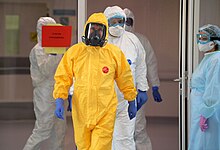
Russia implemented early preventive measures to curb the spread of COVID-19 in the country by imposing quarantines, carrying raids on potential virus carriers and using modern facial recognition technologies to impose quarantine measures.[326]
On 2 March, Western Russia confirmed its first case in Moscow Oblast.[327][328] Previously on 31 January Russia confirmed first two cases in its Asian part, one in Tyumen Oblast and another in Zabaykalsky Krai. Both were Chinese nationals, who have since recovered.[329][326]
On 7 March, four new cases were confirmed, three was in Lipetsk and one in Saint Petersburg. All people visited Italy in the previous two weeks.[330]
On 8 March, three news cases were confirmed, in Moscow, Belgorod and Kaliningrad Oblasts. All people returned from Italy.[331]
On 10 March, Moscow Mayor Sergey Sobyanin signed a decree for banning mass events in Moscow with more than 5000 participants from 10 March to 10 April.[332]
By 15 April, cases were confirmed in all of Western Russia's federal subjects with the confirmation of the first case in Nenets Autonomous Okrug.
San Marino[edit]
On 27 February, San Marino confirmed its first case, an 88-year-old man with pre-existing medical conditions, who came from Italy. He was hospitalised at a hospital in Rimini, Italy.[333] As of 25 March 2020: With 700 confirmed cases out of a population of 33,344 (as of 2018), it is the country with the highest percentage of confirmed cases per capita at 2.1% – 1 confirmed case per 48 inhabitants.[334] Also, with 42 confirmed deaths, the country has the highest rate of confirmed deaths per capita at 0.126% of the total population – 1 death per 794 inhabitants.[334]
Serbia[edit]
On 29 February, a massive infection occurred in the town of Valjevo after a private party involving a guest from Austria who had previously stayed in Italy.[335] On 6 March, the first case was confirmed in Serbia by Minister of Health Zlatibor Lončar,[336] of a man who had traveled to Budapest.[337] President Aleksandar Vucic and the Government of the Republic of Serbia introduced a state of emergency on 15 March. Two days later, curfew and quarantine were introduced as safeguards against massive infection.[citation needed]
Slovakia[edit]
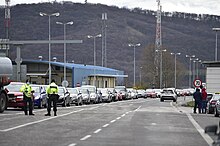

On 6 March, Slovakia confirmed its first case, a 52-year-old man from a small village near Bratislava. He had not travelled anywhere in recent weeks but his son, who didn't show any symptoms, had visited Venice.[338] On 7 March, the virus was also confirmed in his wife and son.[339]
In October 2020, Slovakia started implementation of a short-period mass-testing programme to test two-thirds of its citizens for COVID-19.[340][341]
Slovenia[edit]
On 4 March Slovenia confirmed its first case. A patient of about 60 years of age had returned from Morocco few days earlier (via Italy) and was admitted to a hospital in Ljubljana.[342][343]
On 6 March, a total of eight cases were reported, three of them medical professionals, who contracted the virus on holiday in Italy. By 9 March 16 people were confirmed to be infected.[citation needed]
Spain[edit]

On 31 January, Spain confirmed its first case, in the Canary Island of La Gomera. A tourist from Germany tested positive and was admitted to University Hospital of the Nuestra Señora de Candelaria.[344][345][346][non-primary source needed] On 19 February, 2,500 football fans from Valencia attended a Champions League game in Bergamo, the hot spot of the outbreak in Italy.[347]
On 24 February, a medical doctor from Lombardy, Italy who was vacationing in Tenerife, tested positive at the University Hospital of the Nuestra Señora de Candelaria in Spain.[348][349] Afterwards, multiple cases were detected in Tenerife involving people who had come in contact with the doctor. Other cases involving individuals who visited Italy were also discovered on Spanish mainland.[350]
On Saturday 14 March, the Spanish government imposed a nationwide quarantine, banned all trips that are not necessary and announced that companies may be intervened to guarantee supplies.[351][352] However, with universities and schools closed earlier that week, bars and parks were full, and due to slow enactment "part of the population of Madrid and other cities had dispersed across the country".[347] As of 17 March 2020, there had been 11,826 confirmed cases with 1,028 recoveries and 533 deaths in Spain.[353]
On 28 March, the Spanish government tightened up its national lockdown, ordering all non-essential workers to stay at home for the next two weeks.[354] Nearly 900,000 workers lost their jobs in Spain since it went into lockdown in mid-March 2020.[355] Public transport has also been greatly affected by the lockdowns and the severe restrictions established by the government. The relationship between the users who have continued using the urban bus and the characteristics of the stop's surroundings have been analysed.[356]
On 10 January 2022, Spanish Prime Minister Pedro Sánchez initiated a debate in the European Union to treat COVID-19 as an “endemic illness” rather than a pandemic. He suggested a move towards a flu-like monitoring system amid falling death rates and hospitalisations on the European continent.[357]
Sweden[edit]
On 31 January, Sweden confirmed its first case. A woman in her 20s, who had visited Wuhan, tested positive and was admitted at Ryhov County Hospital in Jönköping.[358][359]
On 26 February, following the outbreak in Italy and in Iran, infection clusters originating from these two countries appeared in Sweden.[360] A number of individuals in Västra Götaland, Jönköping, Stockholm and Uppsala tested positive and were admitted to the infectious disease units in the respective counties.[361]
The country's first fatality came on 11 March, that of a man in Stockholm over 60 who had other illnesses prior to infection.
As of 12 March, national testing strategy shifted to only the elderly, the severely ill, and healthcare personnel. The official recommendation for symptoms that were not serious, as of 13 March, was to stay at home and not visit healthcare. This has led to statistics becoming less useful.[362]
As of 14 March 924 people were reported as having become infected. The Ministry for Foreign Affairs of Sweden made the recommendation to refrain from unnecessary travel to all countries.[citation needed]
On 22 January 2021 the Ministry of Justice of Sweden implemented travel bans from Denmark and the United Kingdom due to the mutation of SARS-CoV-2.[363]
Switzerland[edit]

On 25 February, following the outbreak in Italy, Switzerland confirmed its first case, a 70-year-old man in the Italian-speaking canton of Ticino, who had previously visited Milan.[364][365] Afterwards, multiple cases related to the Italy clusters were discovered in multiple cantons including Basel-City, Zürich and Graubünden.[366][367][368] Multiple isolated cases not related to the Italian clusters were also confirmed.[369]
On 28 February, the Federal Council announced an immediate ban on all ev


 French
French Deutsch
Deutsch